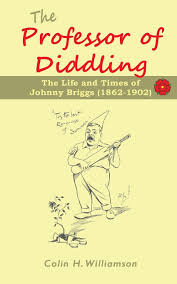The Professor of Diddling
Martin Chandler |Published: 2018
Pages: 175
Author: Williamson, Colin
Publisher: Private
Rating: 3 stars

Lancashire all-rounder Johnny Briggs played for England 33 times back in Victorian times. He was a fine exponent of the game who, amongst other cricketing achievements, scored a century against Australia in just his second Test, and seven years later achieving a hat trick against the same opponents.
Although he hailed from the famous nineteenth century cricketing nursery of Sutton in Ashfield in Nottinghamshire Briggs spent his entire cricket career in Lancashire and was enormously popular in the county of the Red Rose. There was a huge outpouring of grief when he died at the age of just 39 in Cheadle Royal Asylum.
Back in 1902, when Briggs died, publications about professional cricketers were all but unknown and it speaks volumes for the respect that Lancastrians had for Briggs that following his death there were two. One was a statistical record of his achievements in Lancashire colours, and the other a 44 page memoir by Herbert Turner. The latter was republished by Red Rose Books in 2000. That publisher has been involved in a number of booklets that feature Briggs, and also had a hand in the ACS published biography of Briggs by Stuart Brodkin that appeared in 2007, Poor Johnny.
Against that background I was surprised when, a couple of years ago, The Professor of Diddling appeared. It is a privately published biography from a life long Lancashire supporter, Colin Williamson. It is not completely clear from the very short introduction to him what Williamson did with his working life, but it seems to have been in the construction industry, and he retired to Spain in 2002.
The life of Johnny Briggs is undoubtedly an interesting one and, thanks to the interest taken in him during his lifetime, there is a reasonable amount of his life beyond the game available for biographers. Williamson therefore has a decent story to tell and he has clearly researched his subject thoroughly. That said there is, tellingly, no reference in his bibliography to Brodkin’s book, and no reference to any significant new material having come into his possession, perhaps unsurprising given his present location.
Without a great deal to add what has been found by previous researchers Williamson is, essentially, simply rehashing a story that has been told before. It is clear that he is not a professional author, in that some of his sentences are a little long and others would have benefitted from a rather more punctuation but, ultimately, his enthusiasm for and knowledge of his subject shines through and for anyone who is unfamiliar with Briggs story but wishes to know about him they could do much worse than hunt around for a copy of Williamson’s book.
In relation to peripheral matters the book is illustrated but, sadly, the old images have not been reproduced very well. Much better, and thoroughly entertaining, are a number of cartoons originally drawn by Reginald Hill (RIP) where, whilst the sharpness of the original sketches may been lost, the humour has not. On a similar tack it is also a little frustrating that Williamson has not included a statistical appendix, nor an index.
In terms of availability the book was at one point available via Max Books, but their stock would appear to have sold out. Nonetheless the book appears to still be available from Amazon and one or two other online suppliers.






Leave a comment